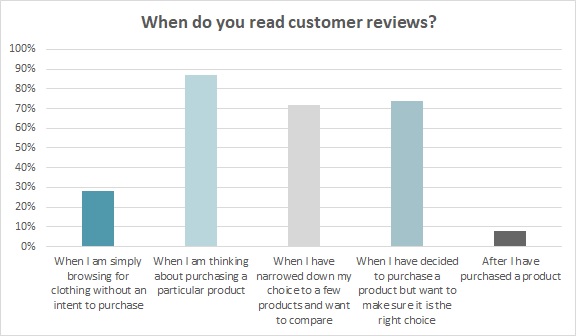How often do you start a product search on Google? You’re not alone. Nearly half of all product searches start on the search engine. And the reviews attached to those products can make or break a relationship with potential or even current customers.
Birdeye, a review management and messaging platform, released a report on the importance of Google reviews that says 92 percent of consumers read online reviews before even visiting a business.
By rewarding customers to leave thorough reviews and share visual user-generated content, businesses can encourage community engagement and strengthen brand advocacy, ultimately boosting retention and CLTV.”
Suz Morris
Content Marketing Writer
“While all review sites are important, Google’s reviews have the most impact because people turn to Google more than any other search engine or review site,” the Birdeye report reads. “We’ve seen that businesses with a higher overall star rating see up to a 35 percent higher clickthrough rate. That means more traffic to your website and more attention from potential customers.”
Moz, a search engine optimization (SEO) and data management software firm, says only a “tiny fraction” of customers will take the time to write a negative review but adds that most consumers will continue to frequent a business that solves their issue. Additionally, about half of all customers will only choose businesses with a rating of four or more stars. Moz says an increase in star ratings and review counts “have proven to increase leads and revenue.”
Among apparel consumers who read reviews, 87 percent of shoppers will read customer reviews when they’re thinking about purchasing a particular product, according to Cotton Incorporated’s Customer Comments Survey (February, 2020). Another 75 percent will read reviews when they have decided to purchase a product but want to “make sure it is the right choice.” And 73 percent will check reviews when they have narrowed down their choice to a few products and want to compare.

When shopping for clothes online, 50 percent of consumers who read reviews say product reviews are influential, according to the 2020 Cotton Incorporated Lifestyle Monitor™ Survey. 86 percent of shoppers who read reviews when shopping for clothing read them to find out about a garment’s quality, according to the Customer Comments Survey. That’s followed by consumers who want information about how the clothes fit (82 percent), sizing (79 percent), value (64 percent), styles – does it look like the item pictured (64 percent), durability (62 percent), comfort (61 percent) and shipping – will it arrive on time and in good condition (38 percent).
Most consumers (84 percent) say they would not buy a garment if they read multiple negative reviews, all citing the same issue (e.g., fit, quality), according to the Customer Comments Survey. About half of all shoppers (49 percent) say they wouldn’t buy a product if they read multiple negative reviews, each citing a separate issue. Another 28 percent say they wouldn’t buy something if they noticed the average star rating is below 4 out of 5 stars. And 28 percent say they wouldn’t buy something even if they really liked it if they noticed multiple reviews that appear to have been computer-generated or written by bots.
To begin managing Google reviews, Birdeye says brands need to claim their Google My Business profile, update their listing with accurate information and a description of their business, and add relevant Google My Business categories. After that, they can start collecting Google reviews. This can be done either manually or through an automated program. Requests for reviews can be made via text or email, included as a link in an email signature or set up as a landing page on the company’s website.
Most consumers (66 percent) say a review of fit/sizing (such as “runs large” or “true to size”) would have “a great deal of influence” on their clothing purchase decision, according to the Customer Comments Survey. Other factors that have a great deal of influence include a customer description of the product (46 percent), whether or not the customer would recommend the product (41 percent), ratings such as comfort and style (40 percent), and the average “star” rating — such as 3.5 out of 5 stars (32 percent).
Birdeye says brands and retailers should , good or bad. Responding to positive reviews can encourage a customer to return. And genuinely responding to negative reviews not only shows a brand’s concern, but it offers the opportunity to fix a problem. Additionally, the company says, quickly responding to negative review might persuade the customer to edit or remove it.
“It’s a great way to build customer loyalty and fix issues before they escalate into bigger problems,” the company states. “Plus, Google has told the world that responding to reviews positively impacts your SEO.”
Of course, Google isn’t the only place consumers can find product reviews. They can be found on social media pages and directly on a retailer or brand’s website.
Yotpo, an ecommerce marketing platform, says brands can drive retention with reviews, notably those from their most loyal customers. The firm’s Suz Morris, content marketing writer, says businesses can boost their customer lifetime value (CLTV) by rewarding their happiest customers and leveraging customer data like product fit, quality, and shipping from reviews.
Morris states. She cites a company that rewards customers who leave thorough reviews on its site with tokens that can be used for discounts on future purchases.
Yotpo’s Morris also points out that brands and retailers can drive customer retention by would have a great deal of influence over their clothing purchase decision.
“Ultimately, as ecommerce continues to grow, brands are tasked with staying relevant and up-to-date in an exceedingly competitive online landscape,” Morris states. “By leveraging existing loyalty, customers’ feedback and incentivizing brand engagement, brands can create emotional connections and sustain brand loyalty virtually.”
